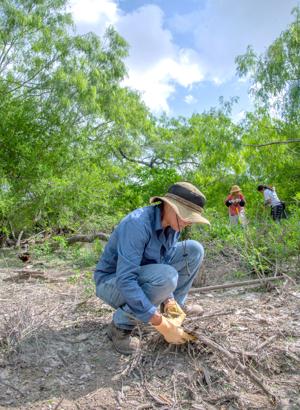

By FERNANDO DEL VALLE, Staff Writer, Valley Morning Star, July 6, 2018
HARLINGEN — The Rio Grande Valley’s native roots are sprouting atop an old landfill blooming into the jewel of the city’s parks system.
For 20 years, volunteers such as Christina Mild have struggled to transform Hugh Ramsey Nature Park into a sanctuary reminiscent of the region before farming and development ravaged the land.
“Ramsey Park has been a grand experiment for me,” Mild, a Texas Master Naturalist, said yesterday.
Since the park opened in 2000, Mild and the volunteers have transplanted native plants and grasses while trying to rid the 53-acre park of guinea grass — a remnant of cattle grazing.
Still, a big question looms over the park.
“Can re-vegetation be successful on a site with tons of garbage buried just inches beneath the soil?” Mild asks.
What it used to be
In the 1960s, the city shut down the sprawling landfill that dated to the city’s founding at the turn of the 20th century, Wiseman, co-chairman of the Rio Grande Valley chapter of the Texas Master Naturalists, said.
Then in 1995, Cameron County Commissioner James Matz led a group that began removing guinea grass while planting trees.
By 2000, the city opened the 53-acre park as Hugh Ramsey Nature Park, named for former Harlingen Mayor Hugh Ramsey, who served in the 1930s and 1940s.
Invasive species
Above the heavy clay soil, a mesquite savannah had grown around swaths of guinea grass, a thick African grass introduced as cattle forage in the mid 20th century, Wiseman said.
“It was mesquite, guinea grass and prickly pear,” Mild, a biologist, said.
Since they began transforming the dumpsite, one of the volunteers’ biggest challenges has been ridding the park of the invasive guinea grass that chokes native plant life.
For years, moving from one spot to another, the volunteers have worked to purge the park of guinea grass.
“In some areas we completely eradicated it and replaced it with native grass,” Wiseman, a retired language teacher, said.
About 15 years ago, the volunteers began transplanting plains bristle grass from the Gloor woods near Brownsville.
“It controls the spread of guinea grass and is not as tall and is more suited for the animal species at the park,” Wiseman said.
Diversity all around
The park is known for its vast diversity of native plants.
Near the banks of the Arroyo Colorado, the volunteers have planted a barreta tree, a member of the citrus family native to the Rio Grande City area.
“It’s a butterfly host plant. It’s blooming now,” Mild said as she plucked lime-green leaves shedding a scent of mint.
“We try to promote varieties of native plants and preserve places for endangered plants,” she said. “Every time we get a good rain I try to seed or bring transplants.”
From the Valley’s western edges, they also planted chomonque, guajillo and Gregg’s mortonia.
“It’s probably the only park in the Valley with native plants from the coast to Rio Grande City,” Wiseman said.
A bird paradise
For birders, the park’s diversity has turned the old dump into a big draw.
So far, 264 species of birds have been identified here, said Norma Friedrich, president of the Arroyo Colorado Audubon Society.
“Ninety percent of the presence of birds here is due to the diverse plants,” Mild said.
Off the trails, bobcats, badgers and javelina roam the thick brush that has become a wildlife corridor.
In many ways, the park has become an educational center.
Along the winding nature trails, the volunteers have planted “gardens” in which signs identify species of native plants.
“We develop as we go. We do small improvements,” Mild said. “It’s a never-ending process. We’re making progress.”
Every day, the volunteers struggle to bring life to the park’s heavy clay soil.
“Clay doesn’t have much organic matter,” Mild said.
Special fertilization
So she spreads fallen leaves as she prepares to plant.
“It increases soil fertilization,” Mild said.
She spreads coffee grounds, too.
“When I go to Starbucks, I ask them for coffee grounds,” Mild said. “It adds nutrients to the soil. Coffee grounds are 100 percent organic matter.”
For the volunteers, the park feels like home.
“Ramsey is a place of worship and ministry for me,” Mild said. “When I visit the park, I experience the visual beauty, the textures, smells and sounds of the natural world around me.”